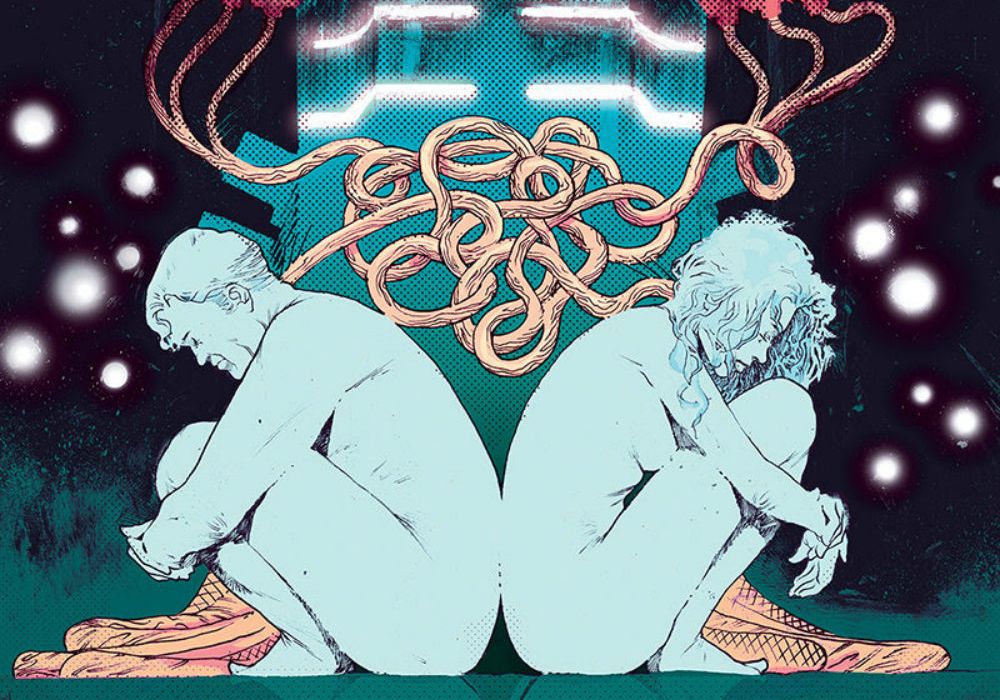Feeling depressed, isolated, or disconnected from your peers? Is your body no longer a suitable vessel for your mind? Continue reading our review to see if inBeing is right for you. But beware, reading reviews can result in seeing spoilers, an unpleasant side effect easily preventable by consuming the comic first.

Written by Zac Thompson & Lonnie Nadler
Illustrated by Piotr Kowalski
Colored by Niko Guardia
Lettered by Ryan FerrierFrom the critically acclaimed writers of THE DREGS and the artist of Image Comics’ SEX comes a new horror series about body image, social media, and memory. When an entrepreneur with a god complex creates a technology that allows two minds to share one body, he doesn’t anticipate the degenerative effects of long-term trials. Come Into Me is a contemporary comment on connected culture and our longing for approval in the digital age. This is a world where technology and flesh become indistinguishable, begging the question, “How much sharing is too much sharing?” Prepare yourself for the insane lovechild of The Fly and Eternal Sunshine of The Spotless Mind.
The division between us has never been truly breached. We use ancient tools like language, biological necessities like sex, or modern technology like social media to try and dissolve the barriers between us. We make every effort to curb the lonely void of ourselves while flailingly attempting to make genuine connections with others. But what if two minds could be connected? Enter inBeing, a revolutionary company committed to answering the mind-body problem. It’s led by Sebastian Quinn, an entrepreneur who wants to change the face of human consciousness forever. But like all god complex-driven biotech companies that want to merge consciousness, you gotta break a few brains first.
The comic’s first images are of fleshy protuberances, a hole in the nape of a woman’s neck and red-clad surgeons prepping for an operation. Umbilical cord-like appendages and fleshy computers immediately call to mind the techno-flesh nightmares of David Cronenberg’s earlier body horror films, a clear inspiration for the series. The opening surgical scene is drawn in the detached, clinical manner of an antiseptic-gloved surgeon. This style continues throughout the issue, and together with the flat, subdued color palette, “Come Into Me” #1 produces a suitably foreboding quality. Like the spectacular failure of the opening surgery, anything can go disastrously wrong at any time. Characters mostly wear apathetic expressions further adding a sense of the mundane. Even when Quinn attempts emotion, he can’t quite hide the vast emptiness inside him. These elements all work together to contrast with later scenes of inBeing in action, where the art takes on a dreamier, more colorful quality. The script and art end up complementing each other thematically as well. Reality is a dull and monotonous slog, and it’s only through technology’s promise of connection that we can find meaning and contentedness.
Whenever inBeing is used, weirdness commences. When Becky first “comes into” Sebastian, a cascade of faded, blurred memories and images coalesces between their heads. It’s the comic’s best single panel, highlighting the strangely beautiful and terrifying heights of inBeing. Kowalski liberally employs this blurring effect throughout. Colors and ink bleed into surrounding images, as if the boundaries between physical objects were more permeable than we thought. Faces blur in a digital smudge and the mental landscape undergoes severe distortion. Maybe it’s an imperfection with the technology or memories warped with time. Or, far more likely, it’s an indication that people aren’t meant to connect on this level. It’s an effective technique that explores this new cerebral space with a sense of trepidation.
When Becky first awakens from within Quinn’s mind, she (or they?) must solve a simple ring puzzle to adjust to their new surroundings. We’re viewing this from their first-person perspective, reminiscent of a video game tutorial. “I don’t know where I end and you begin,” Becky tells Sebastian from within his own mind. Becky’s speech is presented in red caption boxes since she’s no longer able to truly speak. The next page rotates 90 degrees so that readers will have to shift the comic itself to read it right-side up. This may be an irksome feature, but it functions as a clever technique to throw you off balance, mirroring Becky’s disorientation. The panel structure changes again. Fragments of Sebastian’s childhood illness form canted panels surrounded by colored borders. It’s another smart way to show how this must appear to Becky: shards of memory shifting into place to form a clearer picture of her host.
“The deepest principle in human nature is the craving to be appreciated.” This quotation by William James is used on the title splash page, clearly laying out the main characters’ primary motivation. The sixty minutes Becky and Sebastian shared in the same headspace seems to have profoundly affected them. The next four pages see them run through nearly identical routines. These pages function as a palindrome, mirroring each other’s actions with Sebastian and Becky’s panels running vertically down the page, parallel to each other. It’s telling that they’re completely alone in these panels. You can feel their loneliness and longing for true connection, itching to use inBeing again. And like Becky and Sebastian, you’ll find that “Come Into Me” has come into you, burrowing into your subconscious and leaving you waiting for the next issue to hit the shelves.
Final Verdict: 8.9 – “Come Into Me” #1 is a thrilling debut, unsettling and disquieting in its exploration of true connection.



